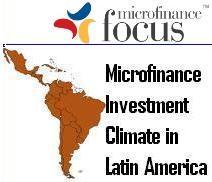There is still a funding shortage for smaller MFIs in Latin America: CEO, Envest
- Friday, January 15, 2010, 18:16
- Latest News
- Add a comment
By Matthew Fuchs
 Jan. 15, 2010: With its mature and dynamic microfinance sector, Latin America is one of the world’s largest microfinance investment markets. As a result, the region’s response to the financial crisis has profound implications for microfinance investment globally. To gauge the current state of the investment climate in Latin America, Microfinance Focus has conducted a survey of fund managers. This is the fourth in the series of our survey findings.
Jan. 15, 2010: With its mature and dynamic microfinance sector, Latin America is one of the world’s largest microfinance investment markets. As a result, the region’s response to the financial crisis has profound implications for microfinance investment globally. To gauge the current state of the investment climate in Latin America, Microfinance Focus has conducted a survey of fund managers. This is the fourth in the series of our survey findings.
Jon Bishop, founder and CEO of Envest, discusses the investment climate in the region. Envest, based in Madison, Wisconsin (US), is a member-driven financial cooperative that uses a variety of financial models to mobilize funding from institutional and individual investors to invest in MFIs, primarily in Latin America.
Microfinance Focus: Has funder appetite for the region been affected by the downturn?
Jon Bishop: Funders have been more reluctant to get involved, but it has more to do with the changes in banking regulations here in the US than the situation in Latin America. We are approaching community banks in Wisconsin for capital. Banking regulations are changing so quickly that banks are reluctant to make a loan for something exotic like microfinance for fear that the loan to us will present compliance problems with some soon to be imposed regulations.
Microfinance Focus: How has the downturn affected MFIs’ demand for funds? Is there a funding shortage or is excessive liquidity an issue?
Jon Bishop: The demand for credit from the MFIs has increased, and the capital available has decreased. There is definitely a funding shortage for the smaller MFIs with whom we work.
Microfinance Focus: A recent Fitch report argues that the impact of the downturn cannot be generalised across regions but varies from country-to-country. Which countries have fared better or worse then others?
Jon Bishop: We have not seen a downturn in portfolio quality in Ecuador. The MFIs were being very conservative in the run-up to the 2009 election. When the elections went smoothly, demand for credit increased as the crisis was getting acute elsewhere.
Our partner in Peru is located in Cusco, which is heavily dependent on tourism. Tourism has declined during the economic downturn, and, while not crippling, it has been felt by the microfinance sector.
Nicaragua is the country in which we have seen the most disruption. The infamous Movimiento No Pago was the most visible part of the problem. Less publicized, but perhaps more important was the weak commodity prices, particularly of cattle. Many MFIs are heavily committed to cattle and have been impacted by the low beef prices. Non-commodity based portions of the portfolio tended to fare better than the commodity based portions. In contrast, solar panel loan portfolios were almost spotless.
Microfinance Focus: Multilateral agencies and DFIs have stepped-up their investment activity over the last year, for example the IFC’s Microfinace Enhancement Facility, OPIC’s new fund for Latin America. Do investors face increased “competition” from multilateral agencies?
Jon Bishop: We work with small MFIs that have little access to the capital coming in from the DFIs. Therefore, we do not see the effects of this capital coming into the market.
Microfinance Focus: The agitation for regulatory change in Nicaragua has been well-publicized. Are there any other moves toward regulatory change in the region? If so, what effect could this have on investment in the region?
Jon Bishop: Nicaragua is the only country in which we are experiencing such problems. Even there, we feel that the risk is tolerable.
© 2010, Microfinance News. All rights reserved. 2008-09
Write a Comment
Gravatars are small images that can show your personality. You can get your gravatar for free today!









